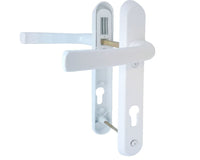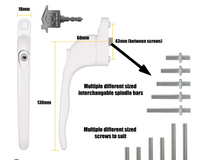If you’ve ever noticed rainwater pooling inside your doorway or felt a chilly draught creeping in, your door may be missing an important layer of protection. Water ingress doesn’t just cause discomfort — over time it can lead to warped frames, damp patches, and higher heating bills. The good news is there’s a simple fix: a door weather bar (also known as a rain deflector or drip board).
🌧 Why Doors Leak in Wet Weather
Even modern uPVC and composite doors can suffer from leaks and draughts if they don’t have proper protection at the base. Common causes include:
-
Gaps at the door threshold where the frame meets the ground
-
Heavy rainfall running directly down the door surface
-
Missing or worn-out weather bars or seals
-
Poor drainage around the door area
When water isn’t diverted away, it can seep inside, damaging flooring, skirting boards, and even the door itself.
🔒 The Role of a Door Weather Bar
A door weather bar is a slim strip fitted horizontally across the bottom of the door. Its job is simple but effective: to deflect rainwater away from the threshold. By preventing water ingress and reducing draughts, it helps keep your home warmer, drier, and more energy efficient.
Unlike bulky draught excluders, a weather bar provides a neat, built-in solution that blends seamlessly with your door.
🛠 The Easiest Fix: uPVC Door Weather Bar – Rain Water Deflector
At Home Secure Shop, we recommend the uPVC Door Weather Bar – Rain Water Deflector / Drip Board.
Here’s why it’s one of the easiest upgrades you can make:
-
Peel-and-stick fitting – comes with high-bond double-sided tape, so no screws or drilling are needed.
-
Quick DIY install – simply clean the surface, cut to size, peel, and stick in place.
-
Extra protection – apply a thin bead of silicone along the top edge after fitting for even greater durability.
-
All-weather performance – keeps rain and draughts out while improving insulation.
-
Universal compatibility – suitable for uPVC, composite, timber, and aluminium external doors.
This small, affordable upgrade makes a big difference — protecting your home from water damage while reducing heat loss.

✅ How to Fit Your New Weather Bar in 5 Steps
-
Clean the door surface thoroughly and let it dry.
-
Measure and cut the weather bar to the correct width.
-
Dry-fit in position 10–15 mm above the threshold.
-
Peel and stick the backing tape firmly along the full length.
-
Seal the top edge with a bead of exterior-grade silicone.
And that’s it — your door now has a built-in rainwater defence system!
🌟 Final Thoughts
If you’re struggling with rainwater leaking under your front or patio door, a weather bar is the quickest and most cost-effective solution. The uPVC Door Weather Bar – Rain Water Deflector / Drip Board offers easy DIY installation, lasting protection, and a neat finish.
👉 Shop the uPVC Door Weather Bar today and keep your home warmer, drier, and more energy efficient all year round.
❓ Frequently Asked Questions
Q: What is a door weather bar?
A: A weather bar (also called a rain deflector or drip board) is a slim strip fitted to the bottom of a door to channel rainwater away from the threshold, helping prevent leaks and draughts.
Q: Do I need screws to fit a uPVC door weather bar?
A: No. The Home Secure™ uPVC Door Weather Bar uses double-sided high-bond tape for quick fitting — no screws or drilling required.
Q: Should I use silicone with a weather bar?
A: Yes. For the best long-term performance, apply a thin bead of exterior-grade silicone along the top edge after installation to seal and improve durability.
Q: Will a weather bar work on composite or timber doors?
A: Absolutely. While designed for uPVC doors, weather bars are also suitable for composite, timber, and aluminium doors.
Q: Can fitting a weather bar help with draughts?
A: Yes. By sealing the bottom edge of the door and deflecting rain, weather bars also reduce draughts, helping to improve energy efficiency.
📚 Featured Collections in this Article
Door Weather Seals & Gaskets
Stop rain and draughts at the source with compression and brush seals for uPVC, composite, and timber doors—available in multiple profiles, kerf/slot types, and colours for a clean, long-lasting fit.
Rain Deflectors & Weather Bars
Surface-mounted aluminium or uPVC deflectors that push water away from the bottom of the door—ideal when wind-driven rain pools at the threshold or blows under the leaf.








